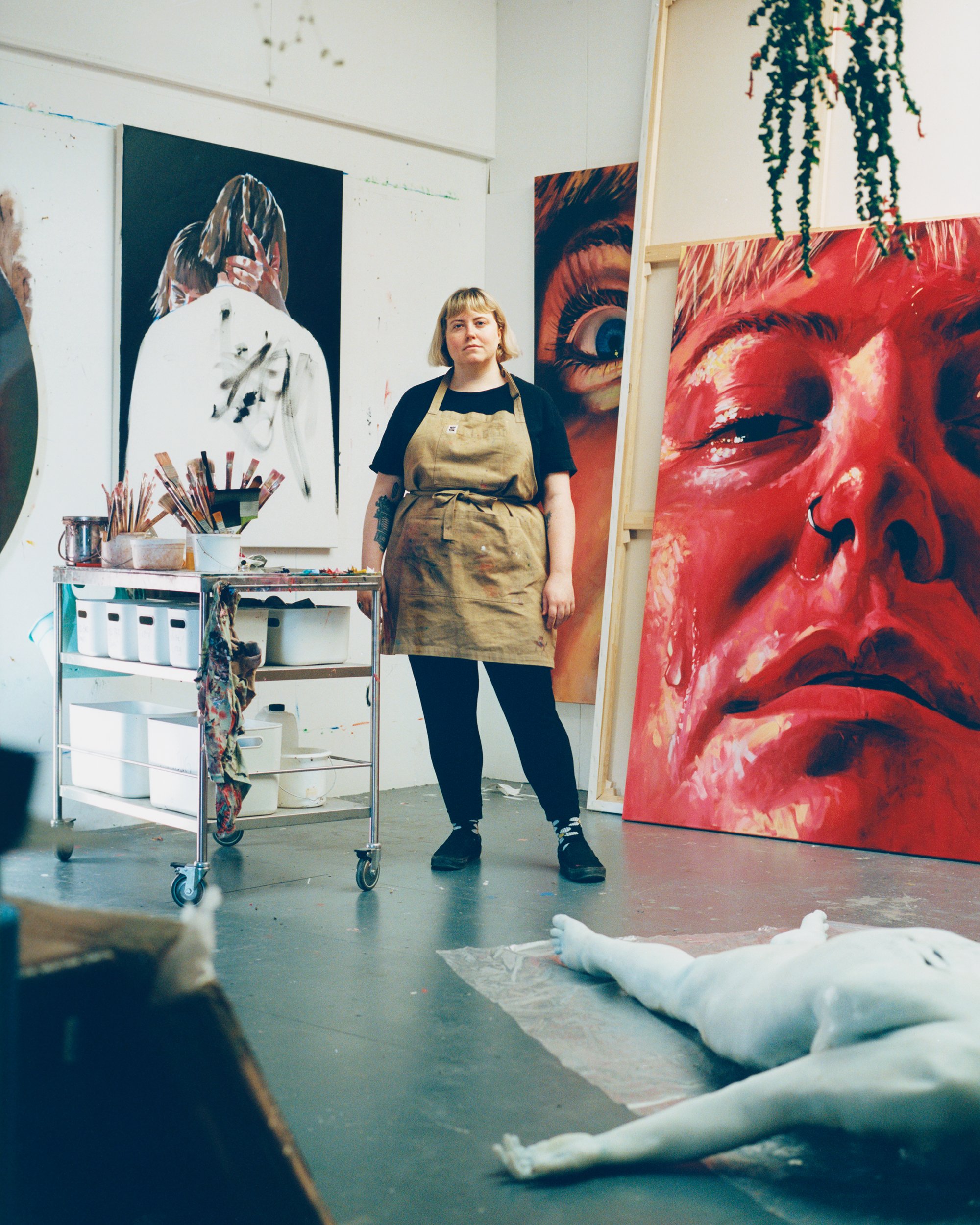
Black blood spurts from the blueish body of an unreal woman—an effigy, a dummy with a waxy pallor. Straddling the dummy, and stabbing it furiously with a knife, is a real woman, naked, with shortly cut blond hair. Her pale flesh, her breasts, move with the momentum of her plunging thrusts. Each lunge sends bursts of black blood into the air. The woman pauses at moments, exhausted from the exertion of violence, her breath heavy, only to resume her attack in bursts. And here’s the most distressing detail: the woman and the effigy are mirror images.
This horror-laced video installation entitled The Body is by American-born, London-based artist Lydia Pettit, and pictures Pettit stabbing a silicone to-scale replica of her own body. The 4-minute-and-23-second film ends on a strangely tender note, as Pettit collapses beside the effigy, both smeared in fake black blood, and the artist reaches gently to hold her hand.
Still from Lydia Pettit’s The Body (2023). Courtesy of the artist and Dinner Gallery.
The film, which was first shown in Berlin at Galerie Judin in 2023, is currently on view at the Armory Show in a solo presentation by New York’s Dinner Gallery. “There is vulnerability but also validation that comes from the conversations I have with strangers as they see me stab myself over and over again,” said Pettit of the experience of showing this highly intimate performance in public. “It is intense emotionally—but I am filled with gratitude that The Body continues to live.”
This haunting effigy is on view at the fair (wounds and all) as well along with four eclipse-shaped paintings by Pettit titled Body Check 1 – 4. Painted with dramatic tenebrism, these new works are viscerally impactful, showing silhouetted ripples of the artist’s flesh and fat against a disorienting pitch-black darkness. “[These paintings] are visual inversions of the value in the film,” Pettit explained, “A streak of white in a black void versus the black splatter in the white void of the film. I wanted these paintings to feel like windows or portals, and extend the concept of the constant, obsessive monitoring of the boundaries and borders of the body that leads to the kind of confrontation depicted in the film.”
Lydia Pettit. Courtesy of the artist.
Pettit, who was born in Maryland in 1991, has, for the better part of a decade, delved into the thorny complexities of body image, weight, femininity, and sexual trauma. Using the visual tropes of horror films, Pettit culls up questions surrounding body politics and mental health. The artist, in recent years, has garnered increased art world attention for her disquieting visual language.
In the summer of 2023, she was featured in the 3-artist show “I Know What You Did Last Summer” at Dinner Gallery, which explored the aesthetics of horror in contemporary art. That same summer, Pettit had her debut solo exhibition with Galerie Judin in Berlin, entitled “In Your Anger, I See Fear.” Shortly after earning her MA in painting at the Royal College of Art in 2020, she was the subject of solo exhibitions at both White Cube, London, and Galerie Sebastien Bertrand, Geneva, both in 2021.
Over the past three or four years, she’s found herself drawn to the aesthetics of Italian horror films, naming Suspiria, the famed horror 1977 film by Dario Argento as a particular influence. In her 2023 exhibition at Galerie Judin, Pettit presented a series of self-portraits depicting herself as both villain and victim. In large-scale paintings, she appears wearing latex gloves or reflected, alarmingly, in mirrors, as a kind of stalker of men. “Those works are about hunger and desire and violence and my fear of desire.”
Installation view of Lydia Petti’s work at the Armory Show, 2024, presented by Dinner Gallery, New York.
While film is a central inspiration, she acknowledges classical references too, particularly in her Baroque embrace of chiaroscuro. Artemesia Gentileschi, fittingly, ranks among her favorite artists. Gentileschi’s famed Judith Beheading Holofernes—a biblical scene of violent revenge exacted by a heroic woman— has been interpreted by many art historians in light of Gentilsechi’s rape by her art teacher. Female rage looms large in many of her works.
Of her own experiences with sexual violence, Pettit recalled “For several years, I was settling into the trauma experienced. It’s a place where you tell people about what’s happened, but it’s like you’re telling a story, not recounting an event you actually experienced. But as the reality was soaking into me, the pain soaks in. There is a period of figuring out how to cope with it. I became fascinated with these stories of mainly women being brutalized.” Women, she noted, are the majority audience for horror and crime media.
Pettit’s current body of painting and film developed from earlier textile-based works, specifically in embroidery and quilting, dating to 2019–2020, in which Pettit isolated gestures and symbols rooted in pop horror. For Pettit, textiles spoke to her fascination with fabric’s intimacy to our bodies, and its ability to become forensic evidence, material witness to scenes of violent encounters.
Installation view of Lydia Petti’s work at the Armory Show, 2024, presented by Dinner Gallery, New York.
These are not themes Pettit feels she’s tackling alone. Pettit sees herself within a nexus of artists using body horror and surrealist disfiguration to approach psychic traumas relating to the female form, along with Hayv Kahraman, Marianna Simnett, and Tai Shani.
“In these artists’ works I also sense this weird dichotomy of surrender and vengeance,” she said. For Pettit, many of her most recent works are about her reintroduction to sexuality as an adult, coming out of a period of asexuality caused by trauma. “For many of us, these feelings are complicated. How frightening and violent and at times gross it feels to want someone,” she said “I think my works speak to these deep frustrations we have about wanting to surrender ourselves from a place of desire but at the same time we may be bursting with rage.”